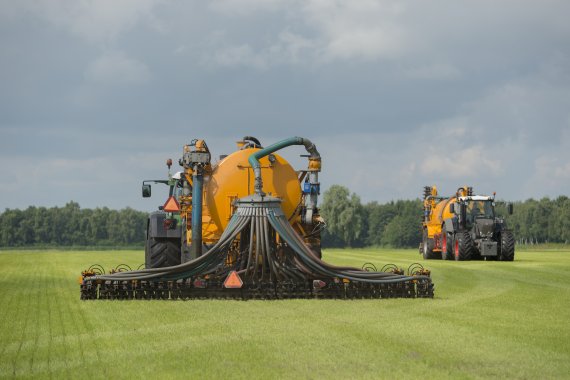When manure is spread in fields, the ammonia emissions are 10 per cent less than was thought. This finding is based on new emission calculations by WUR. The researchers used an improved method to analyse ammonia measurements, both old and new.
In the middle of the nitrogen crisis, the Wageningen researchers Paul Goedhart, Julio Mosquera and Jan Huijsmans have reported on a significant ammonia study. They had actually completed their research before the Council of State shot down the nitrogen programme. Over the past 10 months their study has been double-checked by fellow scientists, before being published this month in the journal Soil Use and Management.
Measurement masts
Since the late 1980s, WUR has been using the integrated horizontal flux method to measure ammonia emissions from manure spread on grassland. In this method, which is also used in other countries, the researchers spread the manure in circles with a diameter of about 50 metres and then install two measurement masts. The first mast is placed in the middle of the circle and measures ammonia concentrations at five to seven different heights. The second mast is placed at some distance downwind from the circle and measures the background concentration of the ammonia in the air.
A device on the mast measures how much ammonia the air contains at different heights, as ammonia concentrations decline the higher you get. The ammonia emissions are then calculated based on the amount of ammonia the wind blows away at different heights. To do this, curves are used that that relate the ammonia concentration and wind speed to the height. These curves are estimated using the measurements.
Criticism
Over the past five years, there has been criticism of the reliability of the ammonia emission estimates. Critics such as Jaap Hanekamp and Geesje Rotgers have also questioned the effectiveness of low-emission manure spreading. ‘We refuted their conclusions in 2017,’ say Goedhart and Huijsmans. ‘They used the wrong statistical method. There can be no doubt about our findings on the effectiveness of low-emission manure spreading.’
Our modified model gives lower emissions in all cases when spreading manure
Even so, statistician Paul Goedhart re-examined the curve that gives the ammonia concentrations at different heights. He found that the curve didn’t fit the ammonia measurements that well and so he came up with an alternative curve. He also allowed for the fact that measurements of higher concentrations are more variable than lower measurements. WUR’s 160 ammonia tests were then analysed again with these improvements. That resulted in estimates of ammonia emissions in fields that are 10 per cent lower.
Emission factor
‘Our modified model gives lower emissions in all cases when spreading manure,’ says Huijsmans. ‘If you use a slurry injector, the emission factor is about 17 per cent, not 19 per cent as we said before. Spreading the manure on the surface gives an emission factor of 63 per cent instead of 70 per cent.’ These emissions are averages and only apply if farmers keep to the rules for low-emission fertilizing. The study by Goedhart, Mosquera and Huijsmans was funded by the Dutch Federation of Agriculture (LTO) and WUR.
Diluted
In the past few years, Huijsmans has also done ammonia measurements with diluted manure. He was sceptical but it turned out that farmers who mix the manure with water shortly before spreading it get lower emissions. Farmers who mix two parts manure with one part water can reduce their ammonia emissions by about 40 per cent.
The research done by van Goedhart, Mosquera en Huijsmans is financed by LTO and WUR.

 Spreading manure with a slurry injector gives an emission factor of about 17 per cent rather than 19 per cent. Photo: Shutterstock
Spreading manure with a slurry injector gives an emission factor of about 17 per cent rather than 19 per cent. Photo: Shutterstock